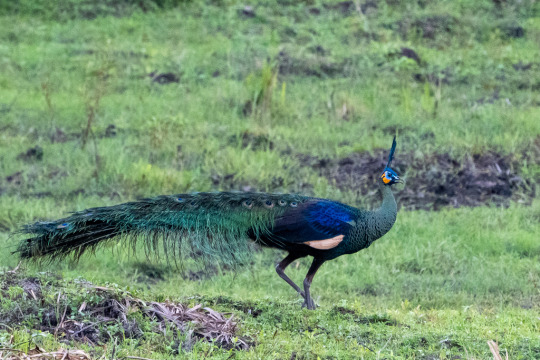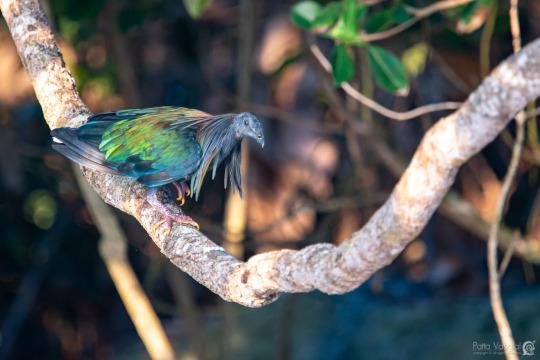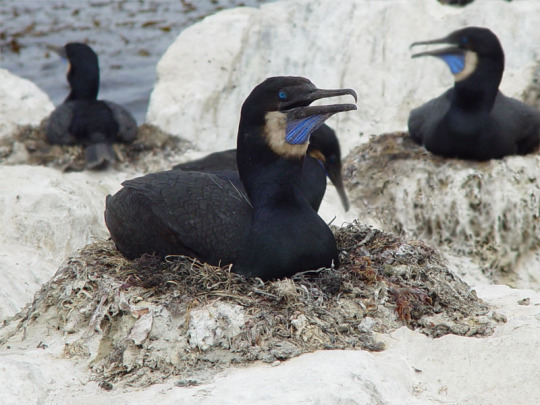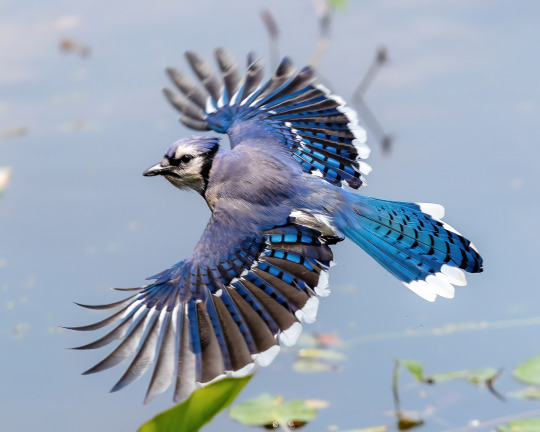(Includes prehistoric birds, with an attempt at image IDs)
Last active 4 hours ago
Don't wanna be here? Send us removal request.
Note
What are the biggest and smallest iridescent birds?
Hello dear Anon! As our bird interest is a bit of a new thing, some research was in order to deduct our answer, and we're still not quite sure. However, we've given you our best attempt. For something perhaps more professional, you might want to go to a-dinosaur-a-day, who we believe is actually qualified to talk about this. We're just a guy obsessed with birds.
Now, explanation out of the way -- the smallest we can tell you with certainty. It is the bee hummingbird, a tiny, the smallest, in fact, bird in the world.

The bee hummingbird (Mellisuga helenae) is only 2 inches long. Females are slightly longer, but only by a small fraction, and usually lay two eggs, with them being the size of coffee beans. Let that sink in. While their iridescent feathers are not as notable as their other hummingbird relatives, they are still there, and still as shiny as ever.
Now, here's where it gets tricky. We're not sure what the biggest iridescent bird is. Taking a guess, we'd say it's the peafowl. But when you look this up, you don't get a concrete answer, which makes sense, because no offense, no one ever asks this question. But don't worry! We side with you here -- we're just as curious.
Well, we've been doing some math here. At first, we were thinking of the microraptor, wondering if a prehistoric bird would count before we remembered the peafowl exists. But we put it to the side. Then, we remembered the resplendant quetzal and its ginormous tail -- we looked around different pages and totaled the tallest possible quetzal to be around 4 foot on the higher end, but it still wasn't enough. So we looked up the peafowl.
The peafowl has 3 types -- all sharing traits but all fairly different in ways. The one we're focusing on right now is the green peafowl.
The green peafowl (Pavo muticus) is the largest peafowl of the three. As its name suggests, it is primarily green, while the indian is primarily a bluish color, and congo variants are kind of brown.

This is the bird we're talking about here. While maybe not in height (but probably in height), it's definitely in length. Males, pictured above, can be 5 feet and 11 inches at lowest to 9 feet 10 inches at highest. And its iridescence is everywhere, from its tail to its beak, basically.
Honestly, we'll be shocked if this isn't the biggest. Wikipedia describes the green peafowl as 'perhaps, the longest extant wild bird in total beak-to-tail length', as well.
We hope this answers your and anyone else's questions, Anon!
TL;DR: It's the bee hummingbird and green peafowl. Probably!
#and take this w a grain of salt#bird#birdblr#avian#iridescent bird#birding#birds#game birds#game bird#pheasant#pheasants#peacock#peafowl#peahen#green peacock#hummingbird#bee hummingbird
31 notes
·
View notes
Note
i was just about to send an ask about grackles. That's funny
hahaha yes so sorry! it was in our drafts for a while now (but we were going to do the boat tailed instead) but we might do the boat tailed later, it's different enough
1 note
·
View note
Text
Shining all over like a star, here's the Common Grackle!

The common grackle is a beautiful bird, especially for the fact it's a backyard bird (in NA, at least) and you can see it normally. They're opportunistic eaters, which means they'll eat anything, including meat. They're also quite smart! They lay up to 7 eggs with two broods a year.
49 notes
·
View notes
Text
Hello everyone, so sorry, we just realized it's impossible to submit or ask anything! We thought it was turned on by default. It's on now, please don't hesitate to send us birds to post!
2 notes
·
View notes
Text
Another pigeon, but domesticated and stunning, the archangel pigeon!

The archangel pigeon (Columba livia domestica) is a breed of domesticated pigeon in the "fancy" category, and one of the ones that are actually morally okay. Their plumage is striking: Black wings with green iridescence, and brown plumage pretty much everywhere else, with signature iridescence on the crop/neck which is pink colored! (However, it may vary. This is just the most popular variant, we believe) All domesticated pigeons, and fancy breeds for that matter all come from the very not domesticated bird, the rock dove, and eventually, the domesticated pigeons from older times became feral pigeons.
#ill be honest im not 100% sure if this picture is an archangel due to the white tipped primaries#but i wanted to be able to credit the person who made the image. look up archangel pigeon if you want tl be safe#bird#birdblr#iridescent bird#avian#birding#birds#dove#pigeon#pigeons#columbidae#columbiformes#columbiforme
139 notes
·
View notes
Text
Strutting in as our next bird; the Nicobar pigeon.

The nicobar pigeon (Caloenas nicobarica) is a pretty good sized pigeon from India! The bird, while known for its fantastic, beaming rainbow iridescent feathers is also known for being the closest living relative of the dodo (yes, the dodo was a pigeon!) and also near threatened. It is also the only living member in its genus. Amazing!
#while our favorite bird is the mourning dove this guy is pretty close up there. how handsome#nicobar pigeon#nicobar#pigeon#columbiforme#columbiformes#columbidae#dodo#pigeons#bird#birds#birb#avian#birdblr
995 notes
·
View notes
Text
A bit less well known, the Brandt's Cormorant!

Perhaps a bit debatable to be put on this blog, the Brandt's Cormorant (Phalacrocorax penicillatus) is a seabird with shiny, weakly iridescent (perhaps even just glossy/shiny, but that's for you to decide and not why it's on here) feathers and a patch of blue, shiny skin (?) on its neck that's used to attract a mate. Also, its scientific name is from its quills that appear on its back during mating season. Its courting ritual is also kind of elaborate if not also kind of silly. It bends its neck backward, almost as if it does not have bones there and flares up its wings, exposing the blue patch. Look it up!
#im so tired i cant formulafe words#bird#birdblr#cormorant#seabird#sea bird#brandts cormorant#avian#iridescent bird
13 notes
·
View notes
Text
Mentioned in our introductory post, the Common Bronzewing!

The common bronzewing, (Phaps chalcoptera) native to Australia, is a very interesting bird, with spectacular iridescence on the wings. Like all pigeons, they're round and build absolutely terrible nests. Interestingly, the females do not lose their iridescent wings in any way, with barely any differences in sexual dimorphism, really.
#we love pigeons so apologies in advance we might favor them a bit more than others#pigeon#columbidae#common bronzewing#bronzewing#bird#birdblr#avian#birding#birds#iridescent bird
584 notes
·
View notes
Text
Our first bird is a fan favorite, the Blue Jay!

The blue jay (Cyanocitta cristata) is a small bird that comes from North America. It's a corvid, in family with crows, ravens, and magpies (and more that we don't feel like listing out) which we didn't know until more recently. An absolute beauty to see in person, but known to be quite mean to other birds at feeders.
#we've only seen a couple around#blue jay#jay#iridescent bird#bird#birdblr#birding#corvid#corvidae#avian#by the way this is our first time doing an id! hope its ok#pls feel free to give criticism just pls be nice
26 notes
·
View notes
Text
Hello, and welcome to ALL IRIDESCENT BIRDS! as the name suggests, we post (at least, attempting) all iridescent birds we can get our hands on. From a tiny speck found on the mallard duck and bronzewing, to full blown from the grackle, we've got you covered. If a bird hadn't been posted yet and you'd love to see it shown, feel free to shoot us an ask/suggestion and we'll take care of it to our nearest convenience. We only have so many hands, after all!
#intro post#birds#bird#birding#birds of prey#birdblr#avian#my pfp is a microraptor btw. if u were curious#iridescent#iridesence#iridescent bird
9 notes
·
View notes